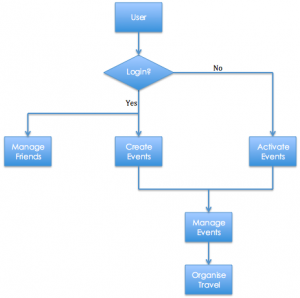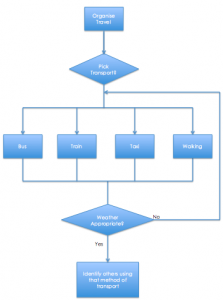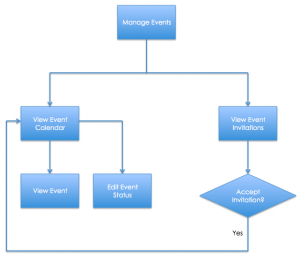This blog illustrates some basic flow diagrams of our system.
Main Flow Diagram
This diagram shows the main functions of the system. If you are a logged in user, then you can manage your friends and create events. If you choose not to login, then you can activate events that you have been invited to. All users can accept event invitations and thus organise their travel within the group.
Travel Flow Diagram
This diagram shows a breakdown of what happens in the organise travel module of the system. The user is shown their different transport options and asked to pick their preferred method, and they can check to see if (depending on the method) it is weather appropriate. For example if they were considering walking, and the weather forecast showed rain, then they might wish to reconsider. Equally if they were considering taking a taxi and the weather forecast showed lovely sunny weather, they might consider walking instead. Once the user has selected their transport method of choice, they will be shown other users that are also taking that transport option.
Event Flow Diagram
This diagram shows a breakdown of what happens inside the manage events module of the system. The users can view their accepted events on a calendar, and their event invitations that they have yet to respond to. They can change their invitation status (aka accept invitations that are outstanding, or change their attending status if their plans change regarding a specific event). Both users who have accounts, and don’t have accounts have the potential to do this. If a user does not wish to create an account they may still keep a record of their events in the following two ways: if they are using the mobile app version of Koh.Tu.Me then it is possible to activate your events within an app, and have those events tied to the app id as opposed to a specific user. That way a user could download the app, activate their events on it, keep that data stored, without ever having to create an account or share any personal information. Being able to achieve the same service using the website version of Koh.Tu.Me is slightly harder. The user can still activate events within a desktop version of the site and opt to have cookies store that event information. That way the cookie will still store the event information for that site for that browser on that specific computer. However, this is the less reliable way as if the browser history is cleared or the user uses a different computer, they will not have access to that information anymore.



Recent Comments